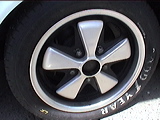Posted on 12/26/2010
Working on your own car can be an interesting and rewarding experience. Some people have a higher mechanical aptitude than others, but performing various basic repairs on your automobile can be mastered by anyone with an interest in doing so. We recommend that owners get more familiar with their car, even if it means changing a flat tire or just checking and setting the tire pressures — as long as the proper tools are utilized and correct procedures followed. For those who would like something more challenging, try performing your own engine oil and filter change. If you have never done this, ask your shop if you can observe their technician during an oil change and if they will explain why and what they are doing during every step of the process. The time and effort you pay to learn the proper procedure could pay big dividends towards your first oil and filter change experience. We recommend utilizing a factory or genuine engin ... read more
Posted on 12/26/2010
Check Engine Light Starting in 1996, all automobiles sold in the United States were mandated by the government to be equipped with On Board Diagnostics II (OBD-II). OBD-II is the protocol of the emissions system; however, it should be considered part of the operating parameters for the engine because it is part of the Digital Motor Electronics (DME) control unit. Much like a scan tool, OBD-II constantly oversees and interrogates the engine, watching for any irregularity or change in operation that is impacting the engine’s emissions. Engine cylinder miss-fires, rich or lean running conditions, cold start operation and fuel tank pressure are just a few of OBD-II oversight responsibilities. Just about any sensor failure or engine operating system is monitored by OBD-II. The Check Engine Light (CEL) is also known as the Malfunction Indicator Light (MIL) or Service Engine Soon Light. When illuminated, it provides a means of notif ... read more
Posted on 12/26/2010
Since the introduction of synthetic lubricants, automotive maintenance has changed drastically. Some automotive manufactures’ recommendations have reached oil change intervals in the 15k and even 20k mile realm, but this does not mean that it is the best recommendation for your engine’s health and extended life. The modern Porsche’s (e.g. the 986-987s and 996-997s) require a more vigorous engine oil change schedule. We suggest that you change your engine oil and filter every 3-5k miles or 6 months (whichever comes first) based on how your car is driven to insure clean internal engine component operation. For cars driven primarily shorter distances (under 10 miles) and/or stop and go traffic a few times (or less) per week, a shorter oil change interval is needed. Cars driven longer distances regularly will do fine with a slightly longer oil change interval. While these service intervals may seem conservative, it is important to recognize that m ... read more
Posted on 12/26/2010
Aside from the GT3/RS, there have basically been two naturally aspirated (non-turbocharged), water cooled, flat 6 cylinder engine designs manufactured by Porsche since the introduction of the 1997 Boxster. These two engine designs are classified with the M96 and the M97 nomenclature. The M97 is superior and has various upgrades over the M96. These upgrades mainly lie in the IMS (intermediate shaft) bearing area, but the M97 was not introduced until the 2006 MY (Model Year). The M96 IMS bearing has been to blame for many of the commonly known engine failures, hence the desirable larger IMS bearing in the M97 engines. The new 997-2 (2009 on) engine (MA1) appeared and is quickly proving to be mechanically superior to both the M96s and M97s. It is classified as the MA1.01 for the 3.8 liter, and MA1.02 for the 3.6 liter. Eliminating the Intermediate Shaft and even one more timing chain, the engine utilizes just two camshaft timing chains, which si ... read more
Posted on 12/26/2010

Since the introduction of the modern steel belted radial tire, automotive tires can now safely last upwards to 80,000 miles. Most automotive manufacturers recommend that tires be in service no longer than 6 years on the vehicle, and no longer than 10 years from the date of manufacture. DOT Number — Mandated by the federal government, every tire has a Department of Transportation number. Up until 1999, the last 3 digits (and from 2000 on, the last 4 digits) of the DOT number describes the week and year the tire was manufactured. For example, tires manufactured in 1999 and earlier with a DOT number ending in 299 would mean the tire was manufactured in the 29th week of 1989 or 1999. From 2000 on, a tire manufactured in the 29th week of 2009 would have 2909. In all actuality, the amount of rubber that touches the road, also known as the contact patch, is only approximately a 3” x 8” rectangular section. Contrary to popular belief ... read more